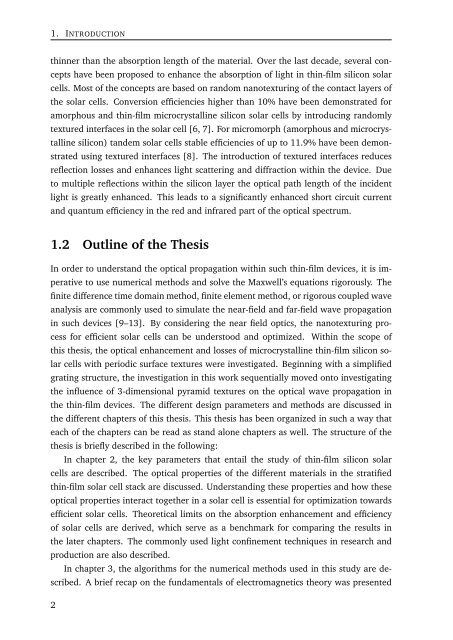Rahul Dewan - Jacobs University
Rahul Dewan - Jacobs University
Rahul Dewan - Jacobs University
You also want an ePaper? Increase the reach of your titles
YUMPU automatically turns print PDFs into web optimized ePapers that Google loves.
1. INTRODUCTION<br />
thinner than the absorption length of the material. Over the last decade, several concepts<br />
have been proposed to enhance the absorption of light in thin-film silicon solar<br />
cells. Most of the concepts are based on random nanotexturing of the contact layers of<br />
the solar cells. Conversion efficiencies higher than 10% have been demonstrated for<br />
amorphous and thin-film microcrystalline silicon solar cells by introducing randomly<br />
textured interfaces in the solar cell [6, 7]. For micromorph (amorphous and microcrystalline<br />
silicon) tandem solar cells stable efficiencies of up to 11.9% have been demonstrated<br />
using textured interfaces [8]. The introduction of textured interfaces reduces<br />
reflection losses and enhances light scattering and diffraction within the device. Due<br />
to multiple reflections within the silicon layer the optical path length of the incident<br />
light is greatly enhanced. This leads to a significantly enhanced short circuit current<br />
and quantum efficiency in the red and infrared part of the optical spectrum.<br />
1.2 Outline of the Thesis<br />
In order to understand the optical propagation within such thin-film devices, it is imperative<br />
to use numerical methods and solve the Maxwell’s equations rigorously. The<br />
finite difference time domain method, finite element method, or rigorous coupled wave<br />
analysis are commonly used to simulate the near-field and far-field wave propagation<br />
in such devices [9–13]. By considering the near field optics, the nanotexturing process<br />
for efficient solar cells can be understood and optimized. Within the scope of<br />
this thesis, the optical enhancement and losses of microcrystalline thin-film silicon solar<br />
cells with periodic surface textures were investigated. Beginning with a simplified<br />
grating structure, the investigation in this work sequentially moved onto investigating<br />
the influence of 3-dimensional pyramid textures on the optical wave propagation in<br />
the thin-film devices. The different design parameters and methods are discussed in<br />
the different chapters of this thesis. This thesis has been organized in such a way that<br />
each of the chapters can be read as stand alone chapters as well. The structure of the<br />
thesis is briefly described in the following:<br />
In chapter 2, the key parameters that entail the study of thin-film silicon solar<br />
cells are described. The optical properties of the different materials in the stratified<br />
thin-film solar cell stack are discussed. Understanding these properties and how these<br />
optical properties interact together in a solar cell is essential for optimization towards<br />
efficient solar cells. Theoretical limits on the absorption enhancement and efficiency<br />
of solar cells are derived, which serve as a benchmark for comparing the results in<br />
the later chapters. The commonly used light confinement techniques in research and<br />
production are also described.<br />
In chapter 3, the algorithms for the numerical methods used in this study are described.<br />
A brief recap on the fundamentals of electromagnetics theory was presented<br />
2

















